Tuesday, Day 5
Chris: Hey, Ellen! How we gonna get this Day 5 email rolling? I’m running out of clever introductions.
Ellen: And so you turn to me for clever? Ha! That’ll teach you. We could, ya know, just say “Hey, folks, here we are again!” and clear up any miscellaneous matters. Such as clarifying that HMA, whom we visited yesterday, is a supplier of unrooted cuttings, not a supplier of liners. Whew! We got that outta the way. Now what?
Chris: That was a rookie mistake. We know perfectly well that HMA only does cuttings. Still, if that was the biggest goof we made yesterday, that’s pretty good. So let’s move on to today’s trials and whether or not we can get through them mistake-free. We covered Syngenta, which you know is housed in Goldsmith’s old greenhouse. Then Proven Winners, at the winery, and finally Danziger, at their usual haunt at Headstart Nursery behind Garlic World, where we also find cyclamen company Varinova. Sounds like an easy day, but there were lots and lots of introductions. How about we each pick three or four favorites from each one? You’ll see these and more in the videos we’ll link to in the section. And remember: this is just our initial coverage. There’ll be more coming in future newsletters. Plus, our giant coverage in the July GrowerTalks/Green Profit.

Syngenta
Okay, Ellen, ladies first.
Ellen: Easy. I’ll start with Sunfinity, Syngenta’s new sunflower. It’s a multi-blooming hybrid, not your run-of-the-mill cut or pot sunflower, for sure. And boy, does it look pretty! It’s sterile, producing little or no pollen. As such, Sunfinity keeps its blooms going a lot longer. To note culturally, it’ll definitely need a pinch, or even two or three—pinching gives it more branches and more blooms. And don’t stick this in a 4-in. pot! Syngenta has 2.5-qt. and 1.5-gal. branded pots available—not required, but the larger size helps. A tag, by the way, is required. Suggested retail price is $15 and higher. Chris, explain why ...
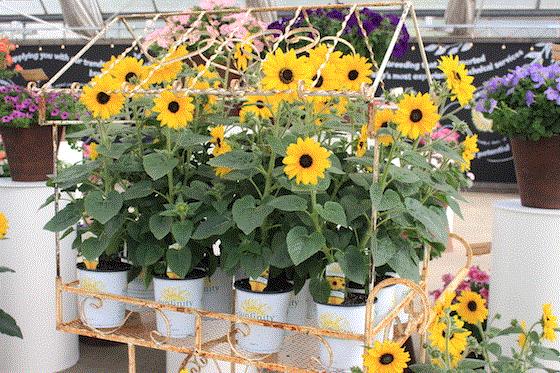
Chris: Syngenta knows they have a premium product on their hands. No other hybrid sunflower (and this is an interspecific hybrid, they tell us) offers quite the show of flowers as Sunfinity, so they are, um, encouraging growers and retailers to get top dollar by asking top dollar themselves—10 times more than what you might pay for a typical sunflower seed or plug. As Ellen said, they do require a branded tag, but not a branded pot. But to get maximum impact, I’d use maximum POP! I asked if they’d gotten pushback from customers when they hear the price; surprisingly, it’s not big growers who are bothered by it, but small growers.

A cascading seed verbena
Chris: Another memorable introduction is Verbena Obsession Cascade. Obsession is their spreading F1 seed verbena; Cascade, obviously, is a cascading version. Now, I’m hardly a verbena expert, but this one is hard to tell from a vegetative verbena; certainly, the average consumer won’t know the difference. It looks great in combos with other premium seed items. In fact, they’ve added it to their Seedsations seed combos. The series starts with five colors, including a nice Twister Violet bicolor.
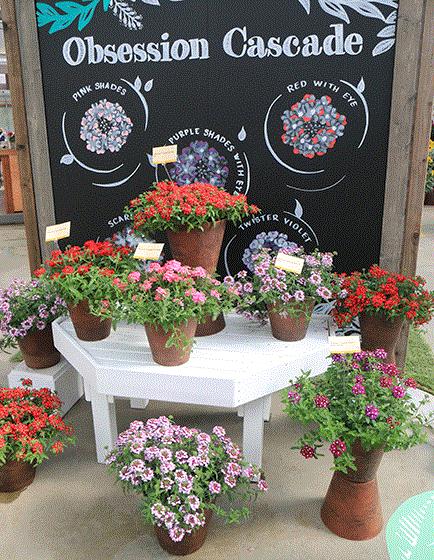
Ellen: My second from Syngenta is the new Calendula series called Caleo. A vegetative hybrid item, it has great powdery mildew tolerance and is durable in lots of weather—even the heat! Just real pretty, too. Two colors—Orange and Yellow.
Chris: I like new series, but sometimes color additions are just as important, as in the case of the well-known Calliope Geranium series. Last year, they dubbed the original Calliope, Calliope Large, and added Calliope Medium, which is more in line size-wise with standard zonal geraniums. Calliope Medium gets five new colors: Burgundy, Red, Deep Rose, Violet and White. I saved White for last because it’s the first White in the Calliope series. And conveniently, it fits in between both Calliope Medium and Calliope Large, so you can grow it with either series. Meanwhile, Calliope Large gets Salmon and Magenta.

A Small Calliope?
Chris: Ellen, you asked a very astute question of Mike Murgiano. Remember what it was?
Ellen: Yes! It was, “If there are Large and Medium Calliope, might there be a Small Calliope somewhere down the line?”
Chris: Smart! Mike’s reply? “We are evaluating that.” Especially considering Syngenta is a global company and Europeans like a geranium that’s a fair bit more compact than we grow here.
Ellen: My last pick from Syngenta are the new additions to the Starcluster Pentas series. Why? Because I like the colors—Pink, Violet and Appleblossom, which, in my mind, looks like a lilac. Any last picks, Chris?
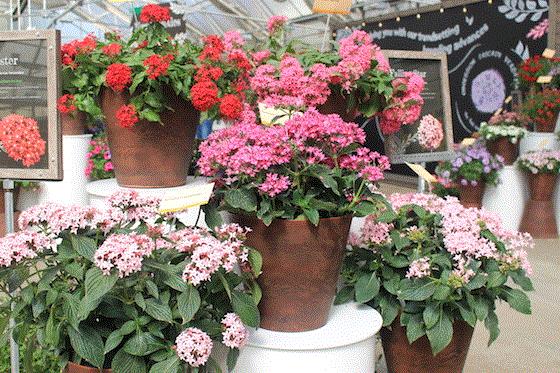
Chris: Hmmm, so many additions, so little time! Nikki and Rhonda, their late-season garden mums? The new Dekko compact vegetative petunia series, which you can even do as a premium pack item? Or the new Midalio compact Dahlia series? No, I’m going old school and picking Viola Penny Black. It’s one of their oldest series, still popular, and I would have thought they’d introduced black a decade ago. Shows they’re still working on it.
We caught all of the above and more on VIDEO! You should watch it.

On to Proven Winners
Chris: Now, on to Proven Winners at their new location (as of last year) at Kirigin Cellars in Gilroy, right around the corner from Syngenta. I’ve gotta say, Marshall Dirks never fails to impress with his ability to capture the current trends in his annual trends presentation. He emphasized the impact of Amazon on plant sales and also both the sharing economy and our views of waste—waste capacity, especially. Think how often we have empty benches or bays. What else can we do with them? And I don’t mean just putting in another crop. Food for thought. Ellen, how about introductions?
Ellen: Back to your previous comment, maybe I’m going old school, too, Chris, but I’m going to pick another calendula! Proven Winners’ is called Lady Godiva Orange and it’s a double. Lady Godiva’s got a bit of a cascading habit, too, but even so, it stays controlled. You might say it could even pass on the growth regulators. Will we see a Lady Godiva Yellow? I hope so.
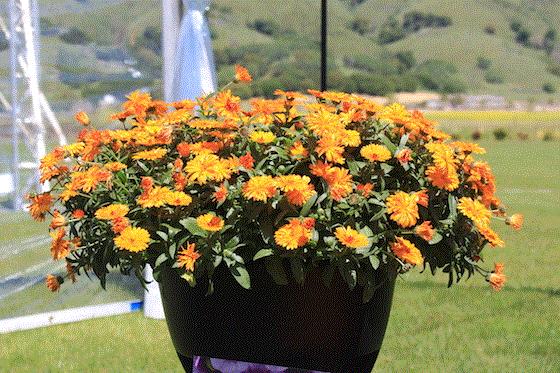
Chris: You can’t beat additions to a popular series for guaranteed sales, so I’ll go with the seven new Superbells Calibrachoa additions, most notably two new doubles: Double Rose and Double Orchid. Now, if you know plant patents, there’s only been one company, Selecta, that can sell double calibrachoa in the U.S. But Proven Winners struck a deal that let’s them do so, too. (We were told they’ve reciprocated with their star pattern, so it’s a win-win.) The new colors in singles include Blue Moon Punch, Rising Star, Hot Pink, Over Easy Improved and White Improved.
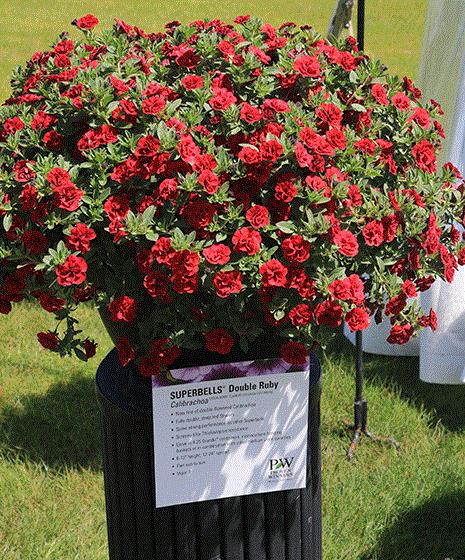
Ellen: I’m gonna go with the Osteo Bright Lights Double Moonglow. Size-wise, it’s a monster! But in a good way … like that big, friendly, furry monster Sully on "Monsters Inc." (I digress). And something I didn’t think about—because it’s a double flower, the flowers don’t close at night. There’s just too much stuff in there to close up. About the color, it’s about the same hue as a warm full moon.
As is our M.O., we've put all of the above on video. In Proven Winner's case, we've segmented them out into ANNUALS, PERENNIALS and SHRUBS.

Shrubs and perennials
Chris: A warm full moon, eh? Hmmm. How much of that pinot noir have you had? Just kidding! That’s a colorful way to put it. I’d have said creamy white. Anyway, on to my second pick from Proven Winners: I’ll swing over to the ColorChoice Shrubs tent where we were shown Quince Double Take Peach. First, it’s the only quince you’ll see at Spring Trials. Second, it’s got a great peachy color that will look good in any garden. Third, double flowers—who doesn’t love double flowers? Fourth, it’s thornless. Lastly, it’s good for Zones 5-9. That’s not all of the country, but lots of it.
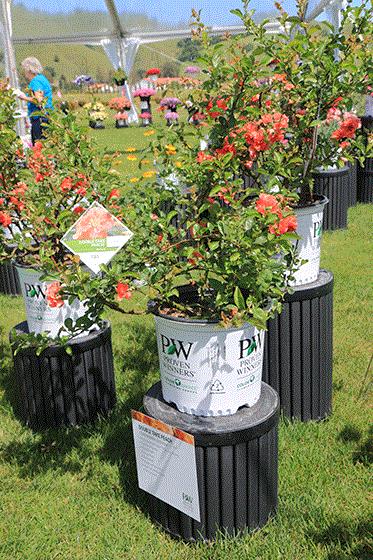
Ellen: My next pick is from Proven Winners’ perennials program and it's Salvia Azure Snow in the Color Spires series. It’s a lovely blue and white bicolor, blooms late spring to early summer and forms compact clumps. And we’re told it doesn’t flop. That’s gotta be the third time this Trials I've heard that very technical “flop” term. Oh, and it’s deer resistant and attracts pollinators, too—both awesome attributes.
Chris: Azure Snow seems like an odd name until you see the combination of blue and white in the flowers. Then it makes sense. Anyway, Ellen, I’m amazed you’ve left me the most vivid of all of Proven Winners intros: Intensia Phlox Red Hot. I won’t try describing the color, since a picture is worth a thousand words:
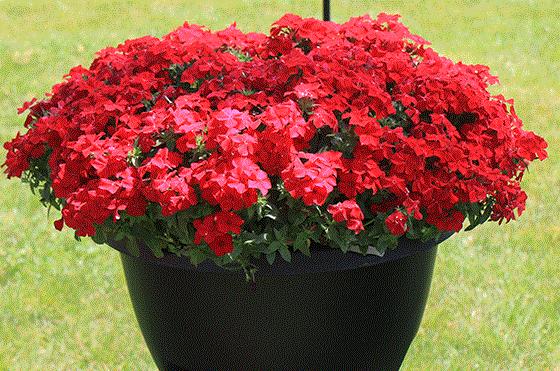
Stunning, eh? You should see it in person. It joins Blueberry and White, which means you're now set for your Independence Day containers.
Ellen: In the ColorChoice Shrubs area, I was drawn to a new baptisia called Decadence Deluxe Pink Lemonade. Now, their Decadence series is known for being somewhat compact. At 3 1/2- to 4-ft. tall, Pink Lemonade isn't as compact, so they decided to called it Deluxe. Or as Christa Steenwyk said, it’s “garden sized.” As for the color, flowers start out as yellow in bud stage, and build to light and darker pink. Just like pink lemonade!
Chris: Just as with Syngenta, we could write all day. But we’ve gotta move on, so I’ll give you just one more and it’s an unusual one: a vegetative hypoestes called Hippo. You know hypoestes as polka dot plant, a cheap and cheerful little 4-in. seed item for windowsills. Hippo is hypoestes on steroids. It will take full shade to some sun, or even full sun if you have plenty of humidity. Hippo starts with Rose and Red; assume that white and pink will be coming. Does the world need a vegetative hypoestes? We'll find out! Okay, Ellen, over to Garlic World and Danziger.

Danziger
Ellen: That’s right, Danziger! One of my favorite trials because of all the color and it’s all displayed so well. Mike Fernandez told us they added about as many varieties as they removed from their catalog, so they’re about even.
Chris: Certainly, no trial is more simply and cleanly laid out. A wall of new varieties, three pots each, perfectly lined up for photography.
Ellen: Anyway, moving on to my fave. I’ll have to say it’s the same as Mike’s and that is petunia Capella Pink Lace. Capella, a new petunia series, is bred for what Mike calls “controlled growth.” Mike said the Israeli breeders asked him what controlled growth meant and his reply was, “It needs to look like it had been treated with Bonzi.” Five total colors, including a Pink Veins.
Chris: Let’s stick with petunias, shall we? First in line was their best-known series, Cascadias, which gets five new colors: Purple Gem, Red Lips, Iceberg, Passion and Blue Omri. Most important are Red Lips, which is a good, bright red. Iceberg is a clean, clear white with no sign of blushing. And Purple Gem is a star-patterned novelty that’s stable and stands up to the weather.
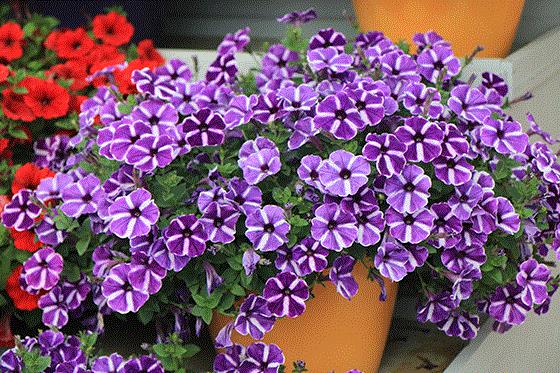
Ellen: Chris, we’ve seen portulaca! First of the trip, no? It’s a whole new series called Pazzaz Nano. Despite the “nano” name, all four colors have fairly large flowers. The interesting thing is, these flowers don’t seem to close! Mike tells us he’s gone into the greenhouse at 5:30 a.m. and the flowers were wide open. We were looking at them at 4:30 p.m. and they were wide open. Why don’t they close? Mike says the breeds chalk it up to good genetics. It’s just the way it is.
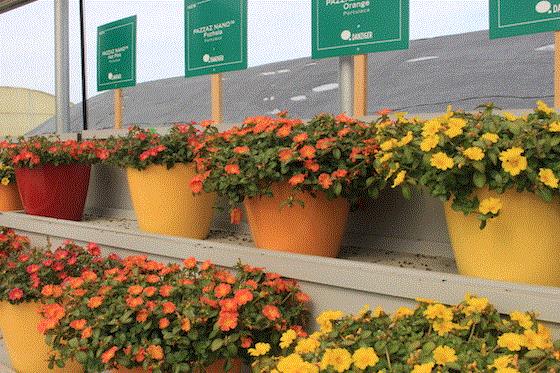
Chris: Odd. I feel like I’ve looked at portulaca for 20 years at the Trials and never once seen one open. Okay, Ellen, one last Danziger intro, a bacopa. I think this may also be a first for this season. Probably because every bacopa that needs to be introduced has been. I mean, white, blue, pink and the story ends … except Danziger seems to have found a pink that will take brutal heat and not stop blooming. Mike told us Scopia Gulliver Pink held up to three weeks of Michigan 90F+ degrees and kept on blooming. Seems that would now make it the model of future Danziger bacopa genetics.
You, too, can see all the color—and learn a bit more about Danziger's varieties—in this VIDEO.

Varinova
Chris: Our last stop of the day was Varinova, in the greenhouse next door to Danziger, where Bart Kuijer showed us his company’s latest cyclamen genetics. It was a trial of Varinova, Syngenta and Morel varieties, but we focused on Varinova. Bart told us he was working on upgrading his best-known series, Maxora, with a new series called Magnia, which is a large-flowered series, and Contigo, which has smaller flowers. Bart talked about something we’ve heard from Morel and other cyclamen breeders: that they make great landscape plants. Are any of you selling or planting cyclamen for the garden? We’d love to know about it. I don’t see it in the Midwest. Ellen, what about New England, where you reside?
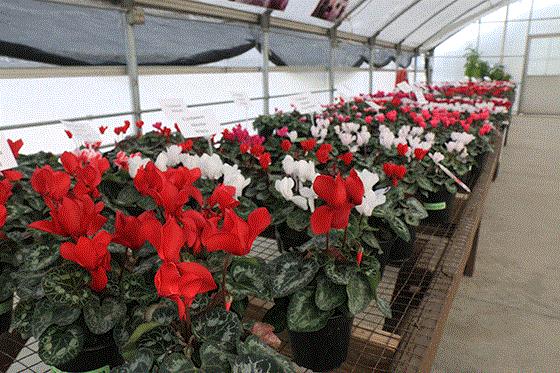
Ellen: I’ve never seen them, but it’s a big region and I should get out more to take a look.
So, Chris, we’re all done with Day 5 and just Day 6 to go: Speedling, Benary and Pacific Plug & Liner. What say you we close out this edition, get some sleep and get on the road tomorrow, eh?
Chris: Wednesday. Our last day (the actual last day of Spring Trials is Thursday) and just three more trials to go. We appreciate all of you who have stuck with us through this adventure. Thanks to those who’ve taken the time to tell us our words, photos and videos are worthwhile. It’s a lot of work, but we’re happy to do it if it gives you a picture and taste of what’s going on out here. See you then!


Chris and Ellen


Chris Beytes
Editor & Publisher
GrowerTalks and Green Profit
Ellen Wells
Editor-at-Large
Green Profit
This email received by 26,512 lucky folks, and you're one of them!
Want to be one of the lucky sponsors who reach those 26,512 readers of Acres of Buzz from Spring Trials? Drop Paul Black a line and he'll tell you what a bargain it is!